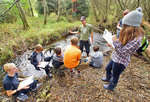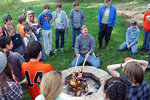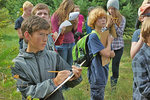Roughly 80 Port Townsend Blue Heron School seventh graders visited Finnriver Farms and the Illahee Preserve, both along Chimacum Creek, on Oct. 3 to see, taste and learn about salmon and their life …
This item is available in full to subscribers.
We have recently launched a new and improved website. To continue reading, you will need to either log into your subscriber account, or purchase a new subscription.
If you had an active account on our previous website, then you have an account here. Simply reset your password to regain access to your account.
If you did not have an account on our previous website, but are a current print subscriber, click here to set up your website account.
Otherwise, click here to view your options for subscribing.
* Having trouble? Call our circulation department at 360-385-2900, or email our support.
Please log in to continue |
|



Roughly 80 Port Townsend Blue Heron School seventh graders visited Finnriver Farms and the Illahee Preserve, both along Chimacum Creek, on Oct. 3 to see, taste and learn about salmon and their life cycle.
Thanks to grant funding provided by the Port Townsend Education Foundation and involvement by the North Olympic Salmon Coalition, the Jefferson County Conservation District, Jefferson Land Trust, Finnriver Farms and Jefferson Healthcare's Executive Chef Aaron Stark, last Friday's field trip marks the start of a yearlong restoration project along Chimacum Creek at Finnriver Farms, where reed canarygrass has choked out native plants, causing organic matter in the creek to increase, which lowers oxygen levels in the water.
Working in groups, students will design their own experiments to combat reed canarygrass. Three visits during the year – one in late winter and another in the spring – will include education about the salmon using the creek, setting up the field study, monitoring the progress of the study and planting trees to replenish the riparian zone.
The goal: allow students to follow the scientific method in designing their own field study, communicate the results of their study to conservation organizations in the region and build relationships with community members and organizations so students can help effect positive change.
Not only are students getting preparation for the Next Generation Science Standards, which are set to replace Washington's State Science Standards in the coming years, they are developing practical solutions to creekside encroachment of invasive species by planting indigenous tree species. Those solutions will be carried forward by community partners addressing the same issues in other areas.
Reed canarygrass needs full sun to thrive. When it does thrive it can be so prolific that it chokes out the native plants. As the grass grows it drops more organic matter into the creek than would be deposited by a forested area. This additional organic material lowers the oxygen levels in the stream.
On Friday, students visited the Illahee Preserve to watch summer chum salmon spawn. Aaron Stark, executive chef at Jefferson Healthcare hospital in PT, demonstrated a traditional method of roasting salmon over a fire. The students also worked to clear blackberry bushes, an invasive species, and toured the land along Chimacum Creek at Finnriver Farms, noting the types of trees growing there.
Before returning to plant trees later in the school year, students will determine which trees would work best to kill off reed canarygrass.
The trees students plant will grow and provide shade that will stunt the growth of the reed canarygrass. This is apparent when looking under existing mature trees where little or no grass is found. As the student-planted trees grow, the shade they provide along the creek will also help lower the water temperature and provide salmon habitat when limbs and trunks fall into the water.
The project was developed this summer as part of a two-day curriculum development workshop offered to Port Townsend Public School teachers as part of the Maritime Discovery Schools (MDS) initiative led by Sarah Rubenstein, MDS Project Director, and Katy Karschney, district curriculum consultant. Twenty-six teachers participated in the workshops in the summer and each teaching team developed an MDS project that they will roll out in the classroom this year. An additional ninety hours of workshops, trainings and teacher professional development are being offered by MDS this school year to further support teachers developing maritime and place-based learning curricula.